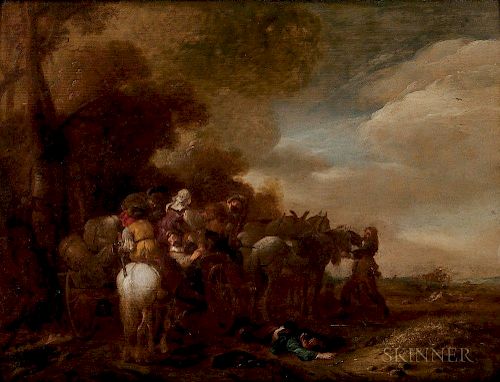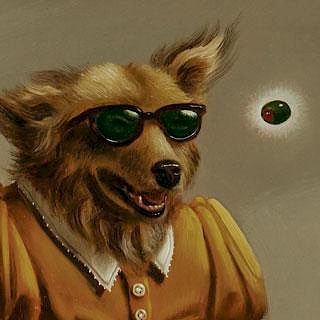Washington Allston (American, 1779-1843) Robbers Fighting with Each Other for the Spoils Over a Murdered Traveler
Lot 250
About Seller
Bonhams Skinner
274 Cedar Hill Street
Marlborough, MA 01752
United States
Founded over four decades ago, Bonhams Skinner offers more than 60 auctions annually. Bonhams Skinner auctions reach an international audience and showcase the unique, rare, and beautiful in dozens of categories, including the fine and decorative arts, jewelry, modern design, musical instruments, sc...Read more
Categories
Estimate:
$70,000 - $90,000
Absentee vs Live bid
Two ways to bid:
- Leave a max absentee bid and the platform will bid on your behalf up to your maximum bid during the live auction.
- Bid live during the auction and your bids will be submitted real-time to the auctioneer.
Bid Increments
| Price | Bid Increment |
|---|---|
| $0 | $10 |
| $100 | $25 |
| $500 | $50 |
| $1,000 | $100 |
| $3,000 | $250 |
| $5,000 | $500 |
| $10,000 | $1,000 |
| $30,000 | $2,500 |
| $50,000 | $5,000 |
| $100,000 | $10,000 |
| $300,000 | $25,000 |
| $500,000 | $50,000 |
| $1,000,000 | $100,000 |
About Auction
By Bonhams Skinner
Sep 27, 2017 - Sep 28, 2017
Set Reminder
2017-09-27 16:00:00
2017-09-28 16:00:00
America/New_York
Bidsquare
Bidsquare : Fine Paintings & Sculpture
https://www.bidsquare.com/auctions/skinner/fine-paintings-sculpture-2653
Bonhams Skinner bidsquare@bonhamsskinner.com
Bonhams Skinner bidsquare@bonhamsskinner.com
- Lot Description
Washington Allston (American, 1779-1843)
Robbers Fighting with Each Other for the Spoils Over a Murdered Traveler
Unsigned, identified and dated "...1801" on a presentation plaque, loan label from Fogg Art Museum (see below), and handwritten provenance label on the reverse.
Oil on panel, 18 7/8 x 26 1/8 in. (48.0 x 64.0 cm), framed.
Condition: Retouch, varnish inconsistencies, hairline horizontal crack to panel 6 inches down from the top, fine craquelure, varnish discoloration, panel beveled on vertical edges, subtle warping to panel.
Provenance: Thomas Lindall Winthrop (1760-1841); Robert Charles Winthrop (1809-1894); Charles Russell Lowell Sr. (1782-1861); New York State private collection; to the present California private collection.
Literature: The Boston Athenaeum Art Exhibition Index, 1827-1874, compiled by Robert F. Perkins, Jr. and William J. Gavin III (Boston: The Library of the Boston Athenaeum, 1980), p. 11; Finding Aid for Washington Allston Materials, as compiled by H.W.L. Dana (1881-1950), Longfellow National Historic Site, Cambridge, Massachusetts, Number 96, Photograph 160, p. 32 and Number 85, Photograph 257, p. 37; William Dunlap, History of the Rise and Progress of The Arts of Design in the United States, Vol. II, first published 1834 (New York: Benjamin Blom, Inc., 1965), p. 301; Jared B. Flagg, The Life and Letters of Washington Allston (New York: Charles Scribner's Sons, 1892), p. 33; Edgar Preston Richardson, Washington Allston: A study of the romantic artist in America (Chicago: University of Chicago Press, 1948), p. 187, no. 25 (Ref.: Dunlap, II, 156; Dana, No. 6); Robert L. White, "Washington Allston: Banditti in Arcadia," American Quarterly, Vol. 13, No. 3 (Autumn 1961), p. 388, article pp. 387-401; William H. Gerdts & Theodore E. Stebbins, Jr. "A Man of Genius" The Art of Washington Allston (Boston: Museum of Fine Arts, 1979), p. 24, ill.; The Correspondence of Washington Allston, Nathalia Wright, editor (Lexington, Kentucky: The University Press of Kentucky, 1993), pp. 23, 240, 333, 565; Kerry Dean Carso, American Gothic Art and Architecture in the Age of Romanic Literature (Cardiff: University of Wales Press, 2014), pp. 34-35.
Exhibitions: Second Exhibition of Paintings in the Athenaeum Gallery, The Boston Athenaeum Gallery, May 1, 1828, as The Robbers, painted in 1809, lent by Dr. Lowell, no. 183.
N.B. Described by sculptor Horatio Greenough as "America's first born poet painter," (1) Washington Allston holds a prominent place in American art history as one of our earliest Romantic artists. Allston was among the first American artists to paint using the sophisticated techniques of the Old Masters, particularly the Venetians (Titian, Tintoretto, and Veronese) and Rubens, and his canvases were admired by his contemporaries for their glazing, rich color, and fine draftsmanship, as well as for their more challenging "grand themes" that included landscape, historical, Biblical, and literary subjects.
The son of a prominent South Carolina family, Allston was educated privately in Newport, Rhode Island, and then at Harvard College, where he graduated in 1800, honored as Class Poet. Returning home to Charleston, Allston disclosed his favorite painting subject at that time to be banditti, or as he later described it "bandittimania," a theme most scholars agree was partly inspired by the 17th century Italian Proto-Romantic artist Salvator Rosa, whose works Allston may have known firsthand. Kerry Dean Carso also points out that Allston was likely influenced by novelist Ann Ward Radcliffe's rich descriptions of banditti set amidst romantic, foreign landscapes, as in The Mysteries of Udolpho: A Romance. (2) Allston reflected on the painting at hand in a letter to William Dunlap in July 1833, writing, "Up to this time my favorite subjects, with an occasional comic intermission, were banditti. - I remember one of these, where I thought I had happily succeeded in cutting a throat! The subject of this precious performance was, robbers fighting with each other for the spoils, over the body of a murdered traveller. And clever ruffians I thought them. I did not get rid of this banditti mania until I had been over a year in England. "(3)
The painting is described by William Gerdts in "A Man of Genius" The Art of Washington Allston, based on a photograph in the Longfellow National Historic Site (this painting's location was unknown at the time of publication in 1979). Dr. Gerdts wrote, "The picture appears rather fluidly, in parts sketchily, handled with an arbitrary drama of light and dark, but a great deal of vigor and activity, and a sense of violent abandon consonant with the subject. The forms are rendered roundly and solidly, in a manner that suggests some acquaintance with actual examples of Flemish seventeenth-century art, and more specifically, with the style of the Dutch artist Philip Wouvermans." (4)
Shortly after this work was painted, Allston left Charleston for London where he studied with Benjamin West, further absorbing the lessons of the Old Masters and expanding his subject matter. He continued his education with sojourns in France and Italy. Since his Harvard days, Allston had a fascination with Italy and found inspiration in the works of Nicolas Poussin and Claude Lorraine. While Allston returned to the United States to make his home in Cambridge, Massachusetts, he would continue to visit Europe regularly, finding there the most kindred intellectual spirits and artistic milieu. He continued to exhibit at the Boston Athenaeum regularly from 1828 until his death.
As noted above, the work at hand bears a label from the Fogg Art Museum which was affixed to the painting when it was brought to the Museum for photography in February 1949 by Mr. Henry Wadsworth Longfellow Dana. The description at the time was "Bandits Robbing Man with Horse and Wagon" by Washington Allston. The work was returned a few days later to 105 Brattle Street which is the address of the current Longfellow National Historic Site, where H.W.L. Dana was compiling the papers of Washington Allston. Allston had deep connections with the Dana family and maintained friendships across several generations after meeting Edmund T. Dana and Richard Henry Dana at Harvard. Allston married Martha Dana, sister of Richard Henry Dana, in 1830.
An old handwritten label on the reverse records T.L. Winthrop as owner, and mentions a second, illegible name, "Judge H. ," whom the note records as having left the painting to T.L. Winthrop. The note also says the painting was left for safekeeping with Mrs. R.C. Winthrop.
1. Horatio Greenough letter to Richard Henry Dana, The Correspondence of Washington Allston, Nathalia Wright, editor, pp. 553-54.
2. Kerry Dean Carso, American Gothic Art and Architecture in the Age of Romantic Literature, pp. 34-35.
3. Jared B. Flagg, The Life and Letters of Washington Allston (New York: Charles Scribner's Sons, 1892), p. 33.
4. William H. Gerdts and Theodore E. Stebbins Jr., "A Man of Genius" The Art of Washington Allston (1779-1843), p. 24.
Estimate $70,000-90,000
Horizontal crack measures about 6 1/4 inches from the right side. The crack runs through the thickness of the panel, with the upper and lower portions separated (but intact) for the first 4 inches. One can see the crack across the recto under raking light. There are minute paint losses along the crack on the right half, but no losses or breaks to the pai - Shipping Info
-
Please visit http://www.skinnerinc.com/services/payment-and-shipping/ for information regarding the collection of items purchased at auction.
-
- Buyer's Premium



 EUR
EUR CAD
CAD AUD
AUD GBP
GBP MXN
MXN HKD
HKD CNY
CNY MYR
MYR SEK
SEK SGD
SGD CHF
CHF THB
THB




















